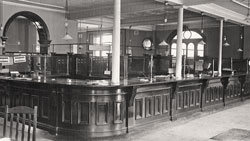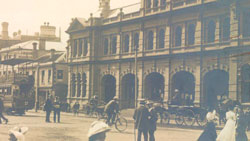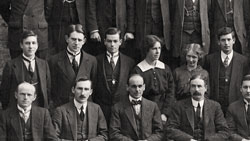From Bank to Battlefield
Profile of Hobart Branch[1]
Hobart's Heroes[2]
At the height of hostilities during World War I, just over half the staff from the Commonwealth Bank of Australia’s (CBA) Hobart Branch had enlisted. As the Reserve Bank descended from the central banking division of the Commonwealth Bank, we honour the staff from the Hobart Branch and share their story.
The Bank was barely two years old when World War I was declared. For Governor Denison Miller, this international calamity posed two very immediate professional challenges, as well as an incalculable personal crisis. On the business front, the Governor was well aware that the war heralded a potential economic crisis and an important central banking role for the newly formed institution; at the same time, he saw that there was an urgent need to keep the Bank’s administrative offices and branch network operational in the face of the mass departure of male employees who were eager to defend the nation.
On this latter issue at least, Governor Miller was able to act quickly and decisively. As well as formalising the Bank’s procedures for military leave, he broke with tradition and temporarily replaced his male bank officers with female staff.
On the home front, he did not manage the shock of the war so well: three of his four sons enlisted, only two returned.
The impact of the war was felt in homes country-wide and in the Bank’s branches across all locations. It was particularly striking in Hobart, Tasmania, where the population was relatively small and the passionate expressions of loyalty to the British Empire were overwhelmingly large. Around 35 per cent of the male population of Tasmania enlisted in World War I – some two-thirds signing up in the first two years. More than half of the 13 000 who served overseas were casualties, with 2 432 losing their lives.
Some 14 of the 22 staff at the CBA’s Hobart branch took part in the war effort. Two of these brave young men (Edwin Clifford Trethewey and Vivian Cyril Brooke) were killed in action while fighting in Harbonnieres, Somme in France and Gallipoli respectively.
The news of Brooke’s death reached the branch in early May 1915, not long before clerk Cyril McIntyre joined the 1st Australian Casualty Clearing Station at Gallipoli. Others were already overseas, including Rupert Pennycuick, who was fighting in Egypt with the 3rd Light Horse Regiment, and John Chambers, who was serving in the 12th Battalion under the command of the branch’s superintendent Ernest Hilmer Smith. Five more bank staff enlisted in 1915 and another two enlisted in 1916 when Australia joined the fighting along the Western Front. Although they served in different battalions and in different spheres of the war, they tried to keep in touch with each other and the staff back in Australia, and to maintain the ties that had been formed in the close-knit Hobart branch.
It took almost two years for the final staff member, Victor Tolland, to return to Australia and receive his discharge after the armistice was declared in November 1918.
Many lives were dramatically changed by the war. Bank employees Thomas McGhee and Victor Tolland both returned to Tasmania as married men ready to settle down with new families. Ernest Hilmer Smith came back a decorated hero after being mentioned in Sir Douglas Haig’s despatches; he was subsequently appointed a Companion of the Order of Bath. Others were happy just to pick up the lives they had left behind and enjoy simple pleasures like re-joining the Bank’s cricket team.
Every one of the men who returned from the war was welcomed back to their positions at the Bank. Many went on to have long and successful careers and a few, like John Chambers, enjoyed some unexpected surprises. Showing that happy endings can appear in even the darkest moments, John went on to marry Kathleen Street, the young woman who had been hired to replace him when he went to war.


